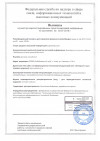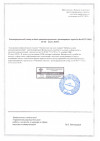Резюме
| Название статьи | НАДПОЧЕЧНИКОВАЯ ДИСФУНКЦИЯ И ЕЕ КОРРЕКЦИЯ ПРИ ПРОВЕДЕНИИ ЭКСТРАКОРПОРАЛЬНОЙ МЕМБРАННОЙ ОКСИГЕНАЦИИ: ПРОСПЕКТИВНОЕ КОГОРТНОЕ ИССЛЕДОВАНИЕ |
|---|---|
| Title | ADRENAL DYSFUNCTION AND ITS CORRECTION DURING EXTRACORPOREAL MEMBRANE OXYGENATION: A PROSPECTIVE COHORT STUDY |
| Категория | номер 2 за 2023 год (опубликован 10.07.2023) |
| Тип | Научная статья |
| Ключевые слова | критическое состояние, гидрокортизон, кортизол, экстракорпоральная мембранная оксигенация, надпочечники, адренокортикотропный гормон |
| Keywords | critical illness, hydrocortisone, cortisol, extracorporeal membrane oxygenation, adrenal glands, adrenocorticotropic hormone |
| Скачать | Скачать статью |
| doi | 10.52485/19986173_2023_2_1 |
| УДК | 616.433, 616.45, 616-06 |
| Резюме | Цель исследования. Оценка влияния гидрокортизона на потребность вазопрессоров в динамике и на выживаемость пациентов при проведении ЭКМО. Материалы и методы. Проспективное когортное исследование было выполнено в отделении реанимации (47 пациентов на ЭКМО). Пациенты были распределены на: Iа (с сосудистой недостаточностью и гипонатриемией и Iб (с изолированной сосудистой недостаточностью без гипонатриемии); группа II (n18) – пациенты без сосудистой недостаточности. Назначение внутривенной терапии гидрокортизоном осуществлялось пациентам с потребностью в норадреналине 0,25 мкг/кг/мин и выше. Результаты. В группе Iа высокая смертность пациентов из-за развернутой клинической картины надпочечниковой дисфункции на фоне низкого уровня кортизола, длительности основного заболевания, перевода пациентов из клиники первичной госпитализации. Пациенты подгруппы Iб показали положительную динамику в разрешении органной дисфункции. Лучшая выживаемость в Iб связана с развитием ранней стадии надпочечниковой дисфункции, когда истощение мозгового слоя надпочечников уже имеет клиническое значение, но компенсаторные способности коркового слоя еще не исчерпали себя, что проявилось в отсутствии гипонатриемии. При этом назначение в этой ситуации гидрокортизона позволяло компенсировать прогрессирующую надпочечниковую дисфункцию. Главным эффектом проводимой гормональной терапии стало именно отсутствие различий в летальности между пациентами группы II и подгруппы Iб, хотя тяжесть состояния пациентов подгруппы Iб была достоверно выше. Также следует учитывать, что ЭКМО - агрессивный метод лечения, несущий в себе независимые риски развития осложнений, повышающих летальность в исследуемых группах. Таким образом, пациенты, исходно имевшие клинические и лабораторные признаки надпочечниковой дисфункции (Iа), несмотря на проводимую терапию гидрокортизоном, компенсацией уровня натрия, показали наибольшую смертность по сравнению с подгруппой Iб и II группой. Заключение. Назначение гидрокортизона позволяет снизить потребность в норадреналине. Применение гидрокортизона при проведении ЭКМО увеличивает выживаемость пациентов. |
| Список литературы | 1. Рябов Г.А. Гипоксия критических состояний. М. Медицина. 1988. |
| 2. Akrout N., Sharshar T., Annane D. Mechanisms of brain signaling during sepsis. Current Neuropharmacology. 2009. 7(4). 296-301. | |
| 3. Tblick A., Peeters B., Langouche L., Van den Berghe G. Adrenal function and dysfunction in critically ill patients. Nature Reviews Endocrinology. 2019. 15(7). 417-27. | |
| 4. Deussing J., Chen А. The corticotropin-releasing factor family: physiology of the stress response. Physiological Reviews. 2018. 98. 2225-86 | |
| 5. Vanhorebeek I., Langouche L., Van den Berghe G. Endocrine aspects of acute and prolonged critical illness. Nature Clinical Practice Endocrinology Metabolism. 2006. 2(1). 20-31. | |
| 6. Pastores S.M., Annane D., Rochwerg B. Guidelines for the diagnosis and management of critical illness-related corticosteroid insufficiency (CIRCI) in critically ill patients (Part II): Society of Critical Care Medicine (SCCM) and European Society of Intensive Care Medicine (ESICM) 2017. Intensive Care Med. 2018. 44. 474-7. | |
| 7. Annane D., Pastores S.M., Rochwerg B., Arlt W., Balk R.A., Beishuizen A., Briegel J., Carcillo J., Christ-Crain M., Cooper M.S., Marik P.E., Meduri G.U., Olsen K.M., Rodgers S.C., RN, MSN, Russell J.A., Van den Berghe G. Guidelines for the diagnosis and management of critical illness-related corticosteroid insufficiency (CIRCI) in Critically Ill Patients (Part I): Society of Critical Care Medicine (SCCM) and European Society of Intensive Care Medicine (ESICM). Crit Care Med. 2017. 45(12). 2078-88. | |
| 8. Annane D., Bellissant E., Bollaert P.E., Briegel J., Keh D., Kupfer Y. Corticosteroids for treating sepsis. Cochrane Database of Systematic Reviews. 2015. 12. CD002243. DOI 10.1002/14651858.CD002243.pub3. | |
| 9. Siemieniuk R.A.C., Meade M.O., Alonso-Coello P., Briel M., Evaniew N., Prasad M., Alexander P.E., Fei Y., Vandvik P.O., Loeb M., Guyatt G.H. Corticosteroid therapy for patients hospitalized with community-acquired pneumonia: a systematic review and meta-analysis. Ann Intern Med. 2015. 163(7). 519-28. | |
| 10. Evans L., Rhodes A., Alhazzani W., Antonelli M., Coopersmith C.M., French C., Machado F.R., Mcintyre L., Ostermann M., Prescott H.S., Schorr C., Simpson S., Wiersinga W.J., Alshamsi F., Angus D.S., Arabi Y., Azevedo L., Beale R., Beilman G., Belley-Cote E., Burry L., Cecconi M., Centofanti J., Yataco A.C., Waele J.D., Dellinger R.P., Doi K., Du B., Estenssoro E., Ferrer R., Gomersall C., Hodgson C., Mller M.H., Iwashyna T., Jacob S., Kleinpell R., Klompas M., Koh Y., Kumar A., Kwizera A., Lobo S., Henry Masur H, McGloughlin S., Mehta S., Mehta Y., Mer M., Nunnally M., Oczkowski S., Osborn T., Papathanassoglou E., Perner A., Puskarich M., Roberts J., Schweickert W., Seckel M., Sevransky J., Sprung C.L., Welte T., Zimmerman J., Levy M. Surviving sepsis campaign: international guidelines for management of sepsis and septic shock 2021. Intensive Care Med. 2021. 47(11). 1181-247. | |
| 11. Евдокимов Е.А., Власенко А.В., Авдеев С.Н. Респираторная поддержка пациентов в критическом состоянии. М. ГЕОТАР-Медиа. 2021. | |
| 12. Millar J.E., Fanning J.P., McDonald C.I., McAuley D.F., Fraser J.F. The inflammatory response to extracorporeal membrane oxygenation (ECMO): a review of the pathophysiology. Crit Care. 2016. 20. 387. | |
| 13. Государственный реестр лекарственных средств. DOI minzdrav.gov.ru/opendata/ 7707778246-grls/visual. Дата обращения 21 ноября 2021 г. | |
| 14. Comparison of systemic glucocorticoid preparations – UpToDate. URL: https://www.uptodate.com/contents/image?imageKey=ENDO%2F64138. Accessed November 21, 2021. | |
| 15. Sauneuf B., Chudeau N., Champigneulle B., Bouffard C., Antona M., Pichon N., Marrache D., Sonneville R., Marchalot A., Welsch C., Kimmoun A., Bouchet B., Messai E., Ricome S., Grimaldi D., Chelly J., Hanouz J.L., Mercat A., Terzi N. Pheochromocytoma crisis in the ICU: a French multicenter cohort study with emphasis on rescue extracorporeal membrane oxygenation. Crit Care Med. 2017. 45(7). e657-e665. DOI 10.1097/CCM.0000000000002333. | |
| 16. Chao A., Wang C.H., You H.C., Chou N.K., Yu H.Y., Chi N.H., Huang S.C., Wu I.H., Tseng L.J., Lin M.H., Chen Y.S. Highlighting Indication of extracorporeal membrane oxygenation in endocrine emergencies. Sci Rep. 2015. 24. 5. 13361. | |
| 17. Kathleen D., Pagana T., Pagana T., Mosby’s Diagnostic and Laboratory Test Reference – Elsevier. 2019. | |
| 18. Combes A., Hajage D., Capellier G., Demoule A., Lavou S., Guervilly C., Silva D.D., Zafrani L., Tirot P., Veber B., Maury E., Levy B., Cohen Y., Richard C., Kalfon P., Bouadma L., Mehdaoui H., Beduneau G., Lebreton G., Brochard L., Ferguson N.D., Fan E., Slutsky A.S., Brodie D., Mercat A. Extracorporeal membrane oxygenation for severe acute respiratory distress syndrome. N Engl J Med. 2018. 24. 378(21). 1965-75. | |
| 19. Debaty G., Babaz V., Durand M., Gaide-Chevronnay L., Fournel E., Blancher M., Bouvaist H., Chavanon O., Maignan M., Bouzat P., Albaladejo P., Labarre J. Prognostic factors for extracorporeal cardiopulmonary resuscitation recipients following out-of-hospital refractory cardiac arrest. A systematic review and meta-analysis. Resuscitation. 2017. 112. 1. | |
| 20. Vasques F., Romitti F., Gattinoni L., Camporota L. How I wean patients from veno-venous extra-corporeal membrane oxygenation. Crit Care. 2019. 23(1). 316. | |
| 21. Fried J.A., Masoumi A., Takeda K., Brodie D. How I approach weaning from venoarterial ECMO. Crit Care. 2020. 24(1). 307. | |
| 22. Rhodes A., Evans L.E., Alhazzani W., Levy M.M., Antonelli M., Ferrer R., Kumar A., Sevransky J.E., Sprung C.L., Nunnally M.E., Rochwerg B., Rubenfeld G.D., Angus D.C., Annane D., Beale R.J., Bellinghan G.J., Bernard G.R., Chiche J.D., Coopersmith C., De Backer D.P., French C.J., Fujishima S., Gerlach H., Hidalgo J.L., Hollenberg S.M., Jones A.E., Karnad D.R., Kleinpell R.M., Koh Y., Lisboa T.C., Machado F.R., Marini J.J., Marshall J.C., Mazuski J.E., McIntyre L.A., McLean A.S., Mehta S., Moreno R.P., Myburgh J., Navalesi P., Nishida O., Osborn T.M., Perner A., Plunkett C.M., Ranieri M., Schorr C.A., Seckel M.A., Seymour C.W., Shieh L., Shukri K.A., Simpson S.Q., Singer M., Thompson B.T., Townsend S.R., Van der Poll T., Vincent J.L., Wiersinga W.J., Zimmerman J.L., Dellinger R.P. Surviving sepsis campaign: international guidelines for management of sepsis and septic shock: 2016. Intensive Care Med. 2017. 43(3). 304-77. | |
| 23. Peeters B., Langouche L., Van den Berghe G. Adrenocortical Stress Response during the Course of Critical Illness. Compr Physiol. 2017. 8(1). 283-98. | |
| 24. Crowder C.M., Evers A.S. Mechanisms of anesthetic action (Chapter 24). Anesthetic pharmacology: basic principles and clinical practice. Cambridge: Cambridge University Press. 2011. 359-84. | |
| 25. Мелмед Ш., Полонски К.С., Ларсен П.Р. Дедов И.И., Мельниченко Г.А. Эндокринология по Вильямсу. Нейроэндокринология. М. ГЭОТАР-Медиа. 2019. | |
| Resume | The aim of the research. Evaluation of the effect of hydrocortisone on the need for vasopressors in dynamics and on the survival of patients during ECMO. Materials and methods. The prospective cohort study was performed in the intensive care unit (47 patients during ECMO). Patients were divided into: Ia (with vascular insufficiency and hyponatremia and Ib (with isolated vascular insufficiency without hyponatremia); group II (n18) - patients without vascular insufficiency. The appointment of intravenous therapy with hydrocortisone was carried out in patients with a need for norepinephrine of 0.25 µg/kg/min and above. Results. In group Ia, there is a high mortality of patients due to: the obvious clinical symptoms of adrenal dysfunction against the background of low cortisol levels, the duration of the underlying disease, the transfer of patients from the primary hospitalization clinic. Patients of subgroup Ib showed a positive trend in the resolution of organ dysfunction. The best survival rate in Ib is associated with the development of an early stage of adrenal dysfunction, when the depletion of the adrenal medulla is already of clinical importance, but the compensatory abilities of the cortical layer have not yet exhausted themselves, which manifested itself in the absence of hyponatremia. At the same time, the appointment of hydrocortisone in this situation made it possible to compensate for progressive adrenal dysfunction. The main effect of the hormone therapy used was precisely the absence of differences in mortality between patients of group II and subgroup Ib, although the severity of the condition of patients in subgroup Ib was significantly higher. It should also be taken into account that ECMO is an aggressive treatment method that carries independent risks of developing complications that increase mortality in the study groups. Thus, patients who initially had clinical and laboratory signs of adrenal dysfunction (Ia) despite ongoing therapy with hydrocortisone and sodium compensation showed the highest mortality compared to subgroup Ib and II group. Conclusion. The appointment of hydrocortisone can reduce the need for norepinephrine. The use of hydrocortisone during ECMO increases the survival rate of patients. |
| Автор 1 | Альтшулер Натаван Эльшад |
| Автор 2 | Куцый Михаил Борисович |
| Автор 3 | Кругляков Николай Михайлович |
| Автор 4 | Аникьева Евгения Анатольевна |
| Автор 5 | Попугаев Константин Александрович |



